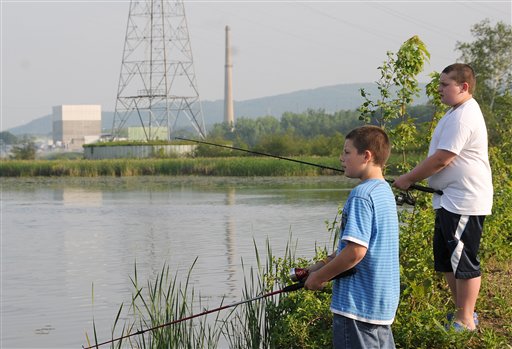
In this May 29, 2010 photo, Shawn Cole, 12, of Hinsdale, N.H., left, and Peter Rosploch, 11, of Winchester, N.H. fish in the Connecticut River across from the Vermont Yankee nuclear power plant. When a fish taken from the Connecticut River recently tested positive for radioactive strontium-90, suspicion focused on the nearby Vermont Yankee nuclear plant as the likely source. Operators of the troubled 38-year-old nuclear plant on the banks of the river, where work is under way to clean up leaking radioactive tritium, revealed this month that it also found soil contaminated with strontium-90, an isotope linked to bone cancer and leukemia. (AP Photo)
MONTPELIER, Vt. — When a fish taken from the Connecticut River recently tested positive for radioactive strontium-90, suspicion focused on the nearby Vermont Yankee nuclear plant as the likely source.
Operators of the troubled 38-year-old nuclear plant on the banks of the river, where work is under way to clean up leaking radioactive tritium, revealed this month that it also found soil contaminated with strontium-90, an isotope linked to bone cancer and leukemia.
Three days later, officials said a fish caught four miles upstream from the reactor in February had tested positive for strontium-90 in its bones. State officials say they don’t believe the contamination came from Vermont Yankee.
Tritium was reported leaking from the plant in January, and since then has turned up in monitoring wells at levels 100 times the federal Environmental Protection Agency’s safety limit for that substance in drinking water. Other radioactive isotopes have been found as well, including cesium-137, zinc-65 and cobalt-60.
Read moreUS: Radioactive fish near Vermont nuklear power plant deemed common














